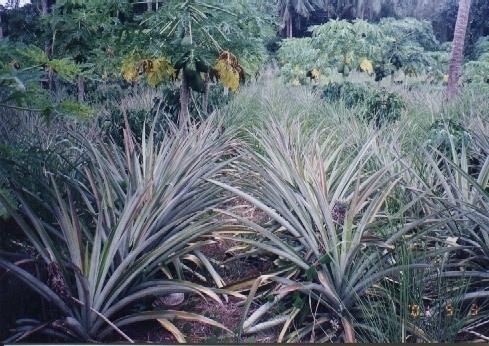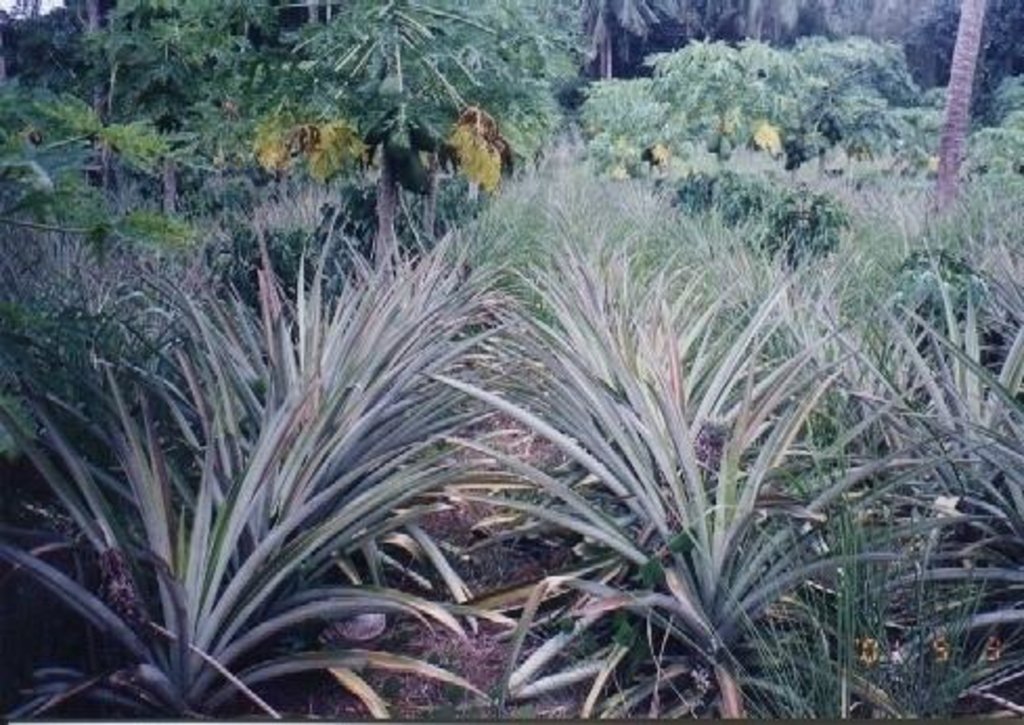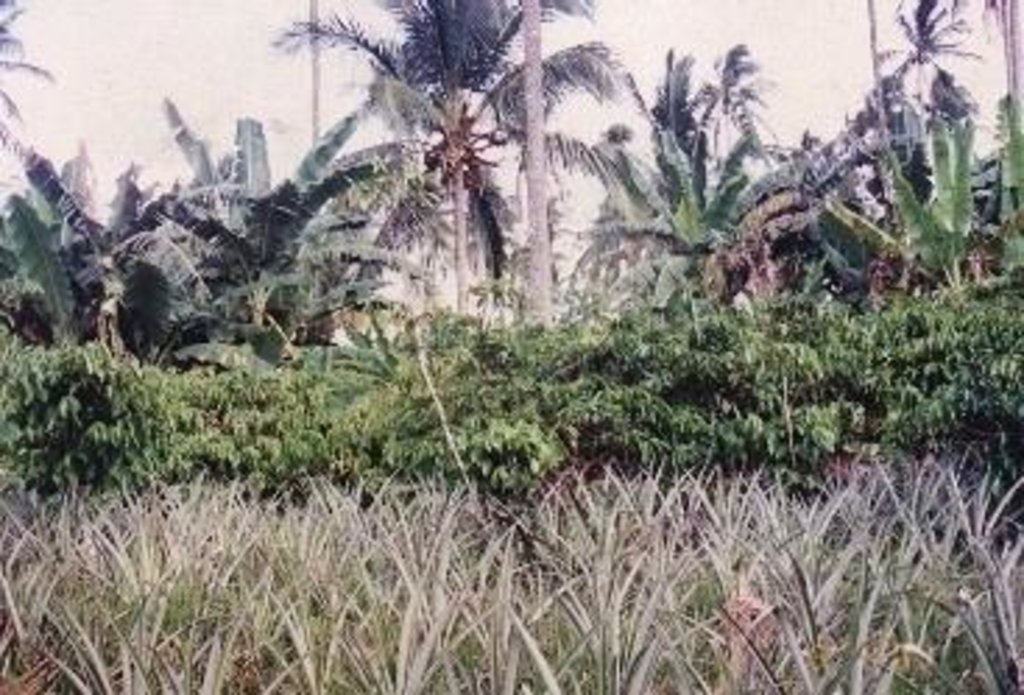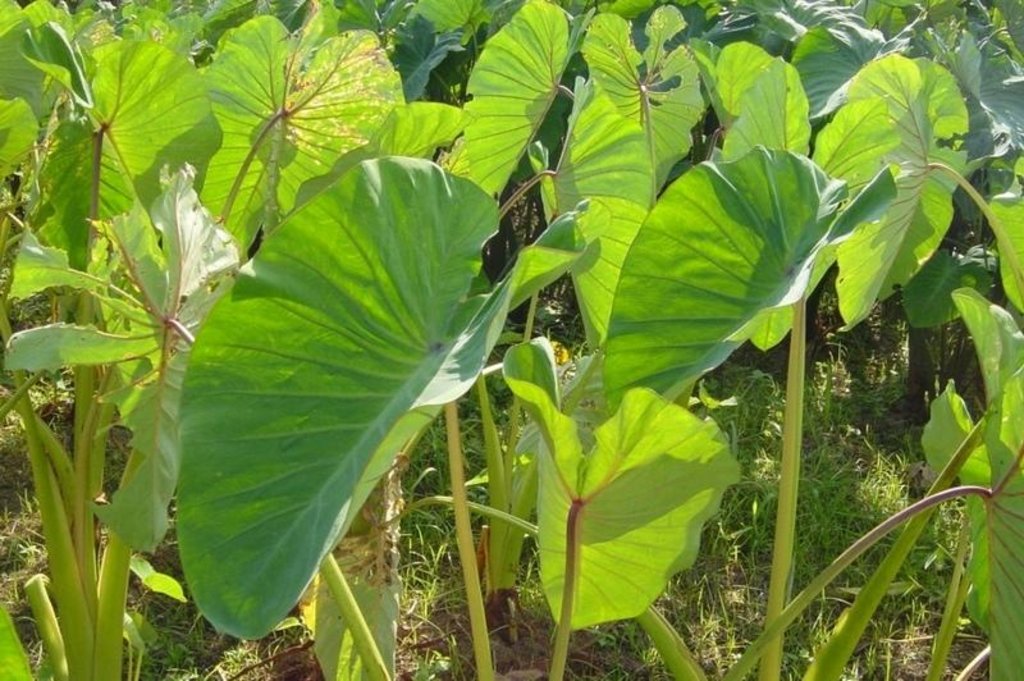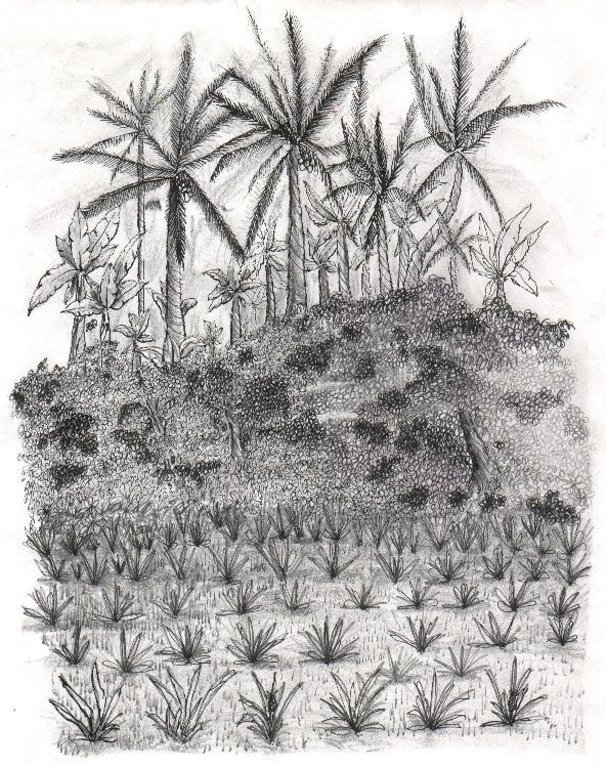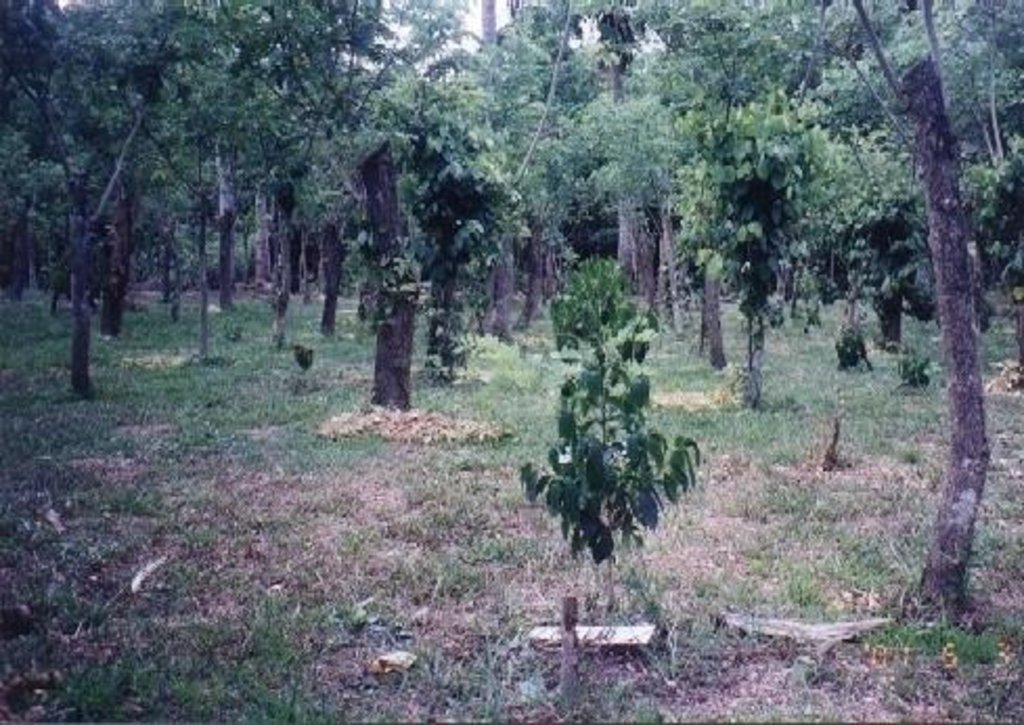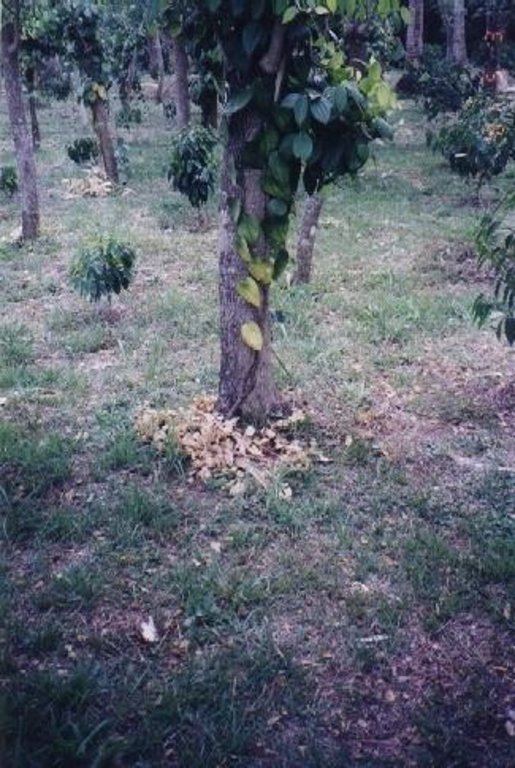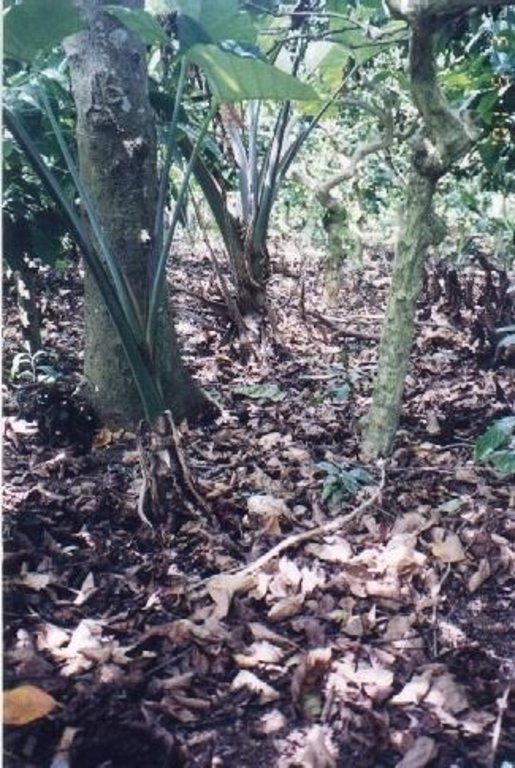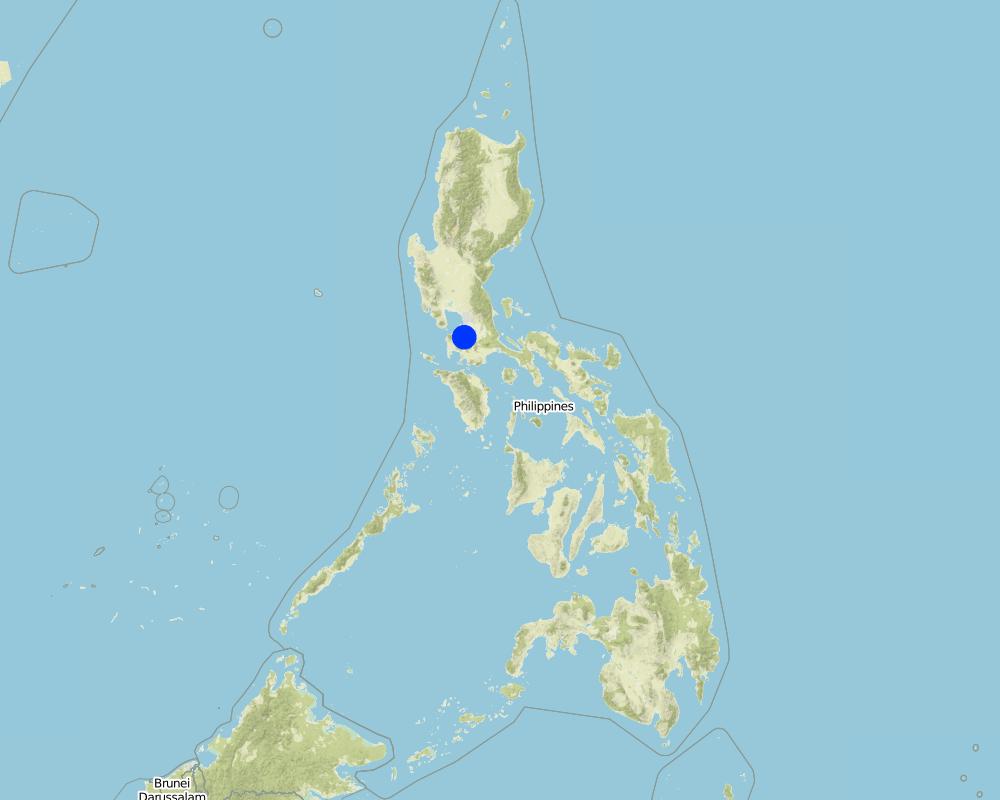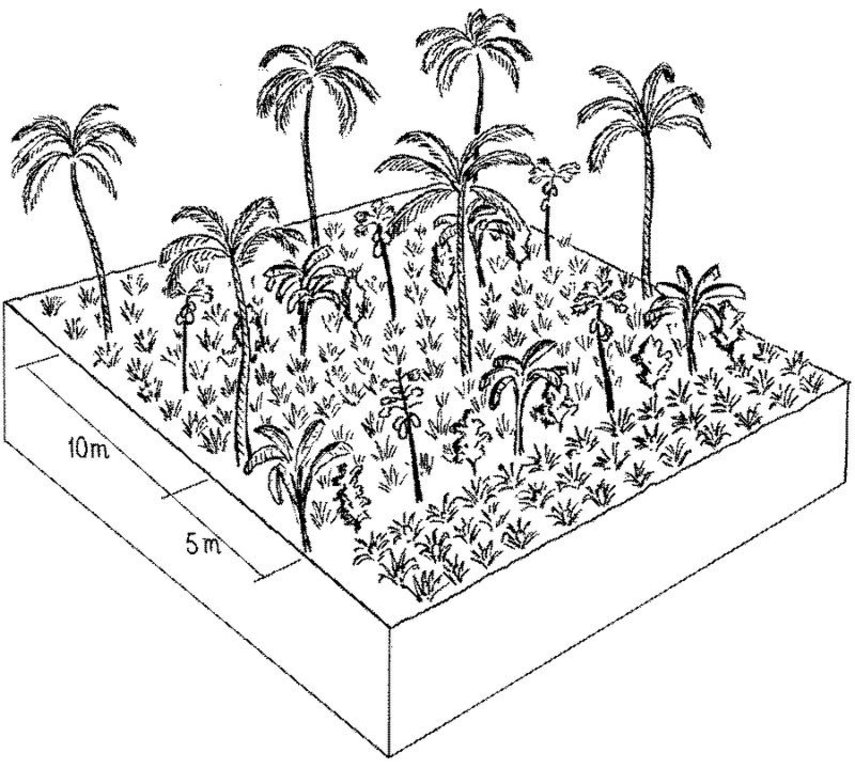Multi-Storey Cropping [الفيليبين]
- تاريخ الإنشاء:
- تحديث:
- جامع المعلومات: Philippine Overview of Conservation Approaches and Technologies
- المحرر: –
- المُراجع: Deborah Niggli
Maramihang Pagtatanim or Planting in Great Numbers
technologies_1103 - الفيليبين
عرض الأقسام
توسيع الكل طي الكل1. معلومات عامة
1.2 تفاصيل الاتصال بالأشخاص الرئيسيين لمصدر المعلومات والمؤسسات المشاركة في تقييم وتوثيق التقنية
متخصص في الإدارة المستدامة للأراضي:
Rondal Jose
joserondal@yahoo.com / bswm@pwolrd.net
Bureau of Soils and Water Management
Diliman, Quezon City, Philippines
الفيليبين
متخصص في الإدارة المستدامة للأراضي:
Mojica Alejandro
(046)4150-013 local 256
admojica@cvsu.edu.ph
Cavite State University
Indang, Cavite, Philippines
الفيليبين
متخصص في الإدارة المستدامة للأراضي:
Rojales Joseph
632-923-04-59
Bureau of Soils and Water Management
Diliman, Quezon City, Philippines
الفيليبين
اسم المشروع الذي سهّل توثيق/تقييم التقنية (إذا كان ذلك على صلة)
Book project: where the land is greener - Case Studies and Analysis of Soil and Water Conservation Initiatives Worldwide (where the land is greener)اسم المؤسسة (المؤسسات) التي سهلت توثيق/تقييم التقنية (إذا كان ذلك على صلة)
Bureau of Soils and Water Management (Bureau of Soils and Water Management) - الفيليبيناسم المؤسسة (المؤسسات) التي سهلت توثيق/تقييم التقنية (إذا كان ذلك على صلة)
Cavite State University (CvSU) - الفيليبيناسم المؤسسة (المؤسسات) التي سهلت توثيق/تقييم التقنية (إذا كان ذلك على صلة)
Farming Systems and Soil Resources Institute, University of the Philippines Los (Farming Systems and Soil Resources Institute, University of the Philippines Los) - الفيليبين1.3 الشروط المتعلقة باستخدام البيانات الموثقة من خلال WOCAT
متى تم تجميع البيانات (ميدانيا)؟:
15/06/2001
يوافق جامع المعلومات والشخص (لاشخاص) الرئيسي لمصدر المعلومات على الشروط المتعلقة باستخدام البيانات الموثقة من خلال WOCAT:
نعم
1.4 إعلان بشأن استدامة التقنية الموصوفة
هل التقنية الموصوفة هنا تمثل مشكلة فيما يتعلق بتدهور الأراضي، بحيث لا يمكن إعلانها تقنية مستدامة لإدارة الأراضي؟:
كلا
2. وصف تقنيةالإدارة المستدامي للأراضي
2.1 وصف مختصر للتقنية
تعريف التقنية:
Cultivating a mixture of crops with different heights (multi-storey) and growth characteristics which together optimise the use of soil, moisture and space.
2.2 وصف تفصيلي للتقنية
الوصف:
Under the maramihang pagtatanim multi-storey cropping system, perennial crops (coconut, banana, coffee, papaya, pineapple) and annuals/biennials (root crops: taro, yam, sweet potato etc) are interplanted to maximise productivity and income. This is most applicable where farms are small and the system needs to be intensive. In this particular area, Cavite, coconuts are usually planted first. When they reach a height of 4.5 meters (after 3-4 years), bananas, coffee and/or papaya are planted underneath. Black pepper may also be part of the system. After sufficient space has developed at ground level in about three to four years, root crops are planted. At full establishment, the system develops different layers: coconut (tallest) followed by banana, coffee, papaya (middle), root crops and pineapple (lowest). In recent years, because of its relatively low productivity and decreasing price, coconut has tended to be replaced in the system with higher value crops like the fruit tree santol (Sandoricum koetjape), papaya and sometimes black pepper. However most multi-storey farms adhere to no specific planting layout. The multi-storey agroforestry system is intended to make the best use of resources (soil, moisture and space) for increased farm income. It is also very effective against soil erosion. Previously, continuous monocropping of annual crops resulted in erosion and serious soil fertility decline. Even though the land is sloping and rainfall during the monsoon is extremely intensive, multi-storey cropping provides adequate soil cover throughout the year, protecting the land from erosion.
Fertilization, weeding and pruning are necessary elements of maintenance. ‘Natural’ mulching through fallen leaves from leguminous trees helps restore and maintain soil fertility The system is applied in a volcanic-derived soil with distinct wet and dry periods (6 months wet season, 6 months dry season). There is the risk of a destructive typhoon every 10 years. Farm income is relatively high, but labour and input costs are also high - and the technology is mostly used by relatively wealthy landowners. There is strong spontaneous adoption, as maramihang pagtatanim has been proven to be effective and remunerative. This technology has been practiced in Cavite since the 1970s. Implementation is by individual farmers with strong extension support from the Local Government Units (LGUs), NGOs and the Cavite State University.
2.3 صور التقنية
2.5 البلد/المنطقة/المواقع التي تم تنفيذ التقنية فيها والتي يغطيها هذا التقييم
البلد:
الفيليبين
المنطقة/الولاية/المحافظة:
Philippines, Cavite
مزيد من التفاصيل حول الموقع:
Cavite
Map
×2.6 تاريخ التنفيذ
في حالة عدم معرفة السنة بالتحديد، يرجى الإشارة إلى التاريخ التقريبي:
- منذ أكثر من 50 عامًا (تقليدي)
2.7 إدخال التقنية
حدد كيف تم إدخال التقنية:
- كجزء من النظام التقليدي (> 50 عامًا)
التعليقات (نوع المشروع، الخ):
It evolved in the area due to necessity.
3. تصنيف تقنية الإدارة المستدامي للأراضي
3.1 الغرض الرئيسي ( الأغراض الرئيسية) للتقنية
- تحسين الإنتاج
- الحد من تدهور الأراضي ومنعه وعكسه
3.2 نوع (أنواع) استخدام الأراضي الحالية حيث يتم تطبيق التقنية

مختلطة (محاصيل/ رعي/ أشجار)، بما في ذلك الحراجة الزراعية
- الحراجة الزراعية
التعليقات:
Major land use problems (compiler’s opinion): Productivity decline, unstable prices of agricultural products and high costs of inputs are the main land use problems. Inputs also have to be increased to maintain the same yield level in annual cropping systems. There is a severe land use competition: a large proportion of the land is being converted to non-agricultural uses, especially residential and industrial areas because of the proximity to the rapidly expanding capital.
Major land use problems (land users’ perception): Productivity decline and unfavourable prices of agricultural products. High costs of inputs.
3.3 مزيد من المعلومات حول استخدام الأراضي
إمدادات المياه للأرض التي يتم تنفيذ التقنية عليها:
- بعلية
عدد مواسم الزراعة في السنة:
- 2
حدد:
Longest growing period in days: 240, Longest growing period from month to month: May - Jan; Second longest growing period in days: 210, Second longest growing period from month to month: May - Dec
3.4 مجموعةالإدارة المستدامة للأراضي التي تنتمي إليها هذه التقنية
- الحراجة الزراعية
- تحسين الغطاء الأرضي/النباتي
3.5 انتشار التقنية
حدد انتشار التقنية:
- منتشرة بالتساوي على مساحة
إذا كانت التقنية منتشرة بالتساوي على منطقة ما، فحدد المنطقة التقريبية المغطاة:
- 100-10 كم2
التعليقات:
Total area covered by the SLM Technology is 40 m2.
Six adjacent municipalities are practicing multi-storey cropping as a system. This is meant to increase income particularly for small farmers.
3.6 التدابير التقنية في مجال إلادارة المستدامة للأراضي

التدابير الزراعية
- A1: الغطاء النباتي/التربة
- A2: المادة العضوية/خصوبة التربة
3.7 الأنواع الرئيسية من تدهور الأراضي التي تناولتها التقنية

تآكل التربة بالمياه
- الوزن(Wt): فقدان التربة السطحية/تآكل السطح

التدهور الكيميائي للتربة
- (Cn): تراجع الخصوبة وانخفاض محتوى المادة العضوية (غير ناتج عن الانجراف)
3.8 منع أو حد أو عكس تدهور الأراضي
تحديد هدف التقنية فيما يتعلق بتدهور الأراضي:
- منع تدهور الأراضي
- الحد من تدهور الأراضي
4. المواصفات الفنية، وأنشطة التنفيذ، والمدخلات، والتكاليف
4.1 الرسم الفني للتقنية
4.2 المواصفات الفنية/شروحات الرسم الفني
Multi-storey cropping includes various species interplanted systematically to optimise use of resources: pineapple and other
root crops (lowest storey); rows of banana trees, coffee and papaya (middle storey); rows of coconut (highest storey). Note: in practice farmers adjust this layout to meet their needs.
Technical knowledge required for field staff / advisors: moderate
Technical knowledge required for land users: moderate
Main technical functions: control of raindrop splash, improvement of ground cover
Secondary technical functions: control of dispersed runoff: retain / trap, increase in organic matter
Mixed cropping / intercropping
Material/ species: coconut, papaya, coffee, banana, pineapple, black pepper, taro, yam...
Quantity/ density: 2500
Remarks: in rows random
Vegetative measure: tree/shrub cover (multi-storey, aligned)
Vegetative material: F : fruit trees / shrubs
Vegetative measure: Vegetative material: F : fruit trees / shrubs
Fruit trees / shrubs species: coconut, coffee, banana, pineapple, black pepper
4.3 معلومات عامة بخصوص حساب المدخلات والتكاليف
عملة أخرى/ عملة وطنية (حدد):
Peso
أشر إلى سعر الصرف من الدولار الأمريكي إلى العملة المحلية (إذا كان ذا صلة): 1 دولار أمريكي =:
50,0
اذكر متوسط تكلفة أجر العمالة المستأجرة في اليوم الواحد:
3.00
4.4 أنشطة التأسيس
| النشاط | نوع التدبير | التوقيت | |
|---|---|---|---|
| 1. | 1. Planting of tallest storey (coconut). | نباتية | early rainy season |
| 2. | 2. Planting of middle storey (coffee and banana). | نباتية | early rainy season |
| 3. | 3. Planting of lowest storey (pineapple). | نباتية | early rainy season |
| 4. | 4. Planting of lowest storey continued (root crops). | نباتية | early rainy season |
4.5 التكاليف والمدخلات اللازمة للتأسيس
| تحديد المدخلات | الوحدة | الكمية | التكاليف لكل وحدة | إجمالي التكاليف لكل مدخل | % من التكاليف التي يتحملها مستخدمو الأراضي | |
|---|---|---|---|---|---|---|
| العمالة | labour | ha | 1,0 | 150,0 | 150,0 | 100,0 |
| معدات | animal traction | ha | 1,0 | 50,0 | 50,0 | 100,0 |
| معدات | tools | ha | 1,0 | 40,0 | 40,0 | 100,0 |
| المواد النباتية | seedlings | ha | 1,0 | 840,0 | 840,0 | 100,0 |
| الأسمدة والمبيدات الحيوية | fertilizer | ha | 1,0 | 160,0 | 160,0 | 100,0 |
| الأسمدة والمبيدات الحيوية | biocides | ha | 1,0 | 30,0 | 30,0 | 100,0 |
| الأسمدة والمبيدات الحيوية | compost/manure | ha | 1,0 | 120,0 | 120,0 | 100,0 |
| إجمالي تكاليف إنشاء التقنية | 1390,0 | |||||
التعليقات:
Duration of establishment phase: 60 month(s)
4.6 الصيانة/الأنشطة المتكررة
| النشاط | نوع التدبير | التوقيت/الوتيرة | |
|---|---|---|---|
| 1. | 1. Pruning. | زراعية | |
| 2. | 3. Harvesting. | زراعية | |
| 3. | 2.Weeding | زراعية | |
| 4. | 4. Spraying. | زراعية | |
| 5. | 5. Fertilizing. | زراعية |
4.7 التكاليف والمدخلات اللازمة للصيانة/للأنشطة المتكررة (سنويًا)
| تحديد المدخلات | الوحدة | الكمية | التكاليف لكل وحدة | إجمالي التكاليف لكل مدخل | % من التكاليف التي يتحملها مستخدمو الأراضي | |
|---|---|---|---|---|---|---|
| العمالة | labour | ha | 1,0 | 300,0 | 300,0 | 100,0 |
| الأسمدة والمبيدات الحيوية | fertilizer | ha | 1,0 | 160,0 | 160,0 | 100,0 |
| الأسمدة والمبيدات الحيوية | biocides | ha | 1,0 | 30,0 | 30,0 | 100,0 |
| إجمالي تكاليف صيانة التقنية | 490,0 | |||||
التعليقات:
Machinery/ tools: animal draft wooden plough, machete, iron bar and spade, machetes, harrows, bolo.
Cost was calculated assuming a per hectare population of 100 coconuts, 400 coffee plants and 3,000 pineapples.
Maintenance activities entail more work than during the establishment phase. Note that the establishment phase usually lasts for 4-5 years, so the labour is spread, unlike during the maintenance phase when all of the components have to be attended to.
4.8 أهم العوامل المؤثرة على التكاليف
قدم وصفا لأهم العوامل التي تؤثر على التكاليف:
Labor is the most crucial especially during land preparation and planting, maintenance and harvesting.
5. البيئة الطبيعية والبشرية
5.1 المناخ
هطول الأمطار السنوي
- < 250 مم
- 251- 500 ملم
- 501 - 750ملم
- 1,000-751 ملم
- 1,500-1,100 ملم
- 2,000-1,500 ملم
- 3,000-2,001 ملم
- 4,000-3,100 ملم
- > 4000 ملم
المنطقة المناخية الزراعية
- رطبة
Thermal climate class: tropics
5.2 طوبوغرافيا
متوسط الانحدارات:
- مسطح (0-2%)
- بسيط (3-5%)
- معتدل (6-10%)
- متدحرج (11-15%)
- تلال (16-30%)
- شديدة الانحدار(31-60%)
- فائقة الانحدار (>60%)
التضاريس:
- هضاب/سهول
- أثلام مرتفعة
- المنحدرات الجبلية
- منحدرات التلال
- منحدرات في السفوح
- قاع الوادي
المنطقة الارتفاعية:
- 100-0 متر فوق سطح البحر
- 500-101 متر فوق سطح البحر
- 1,000-501 متر فوق سطح البحر
- 1,500-1,001 متر فوق سطح البحر
- 2,000-1,501 متر فوق سطح البحر
- 2,500-2,100 متر فوق سطح البحر
- 3,000-2,501 متر فوق سطح البحر
- 4,000-3,001 متر فوق سطح البحر
- > 4000 متر فوق سطح البحر
5.3 التربة
متوسط عمق التربة:
- ضحل جدًا (0-20 سم)
- ضحلة (21-50 سم)
- متوسطة العمق (51-80 سم)
- عميقة (81-120 سم)
- عميقة جدًا (> 120 سم)
قوام التربة (التربة السطحية):
- متوسط ( طميي، سلتي)
المواد العضوية في التربة السطحية:
- عالية (>3%)
- متوسطة (1-3%)
5.6 خصائص مستخدمي الأراضي الذين يطبقون التقنية
التوجه السوقي لنظام الإنتاج:
- مختلط (كفاف/ تجاري)
- تجاري/سوق
الدخل من خارج المزرعة:
- 10-50% من جميع الإيرادات
المستوى النسبي للثروة:
- متوسط
- ثري
مستوى المكننة:
- عمل يدوي
- الجر الحيواني
اذكر الخصائص الأخرى ذات الصلة لمستخدمي الأراضي:
Population density: > 500 persons/km2
Annual population growth: 2% - 3%
10% of the land users are very rich and own 40% of the land.
60% of the land users are rich and own 40% of the land.
20% of the land users are average wealthy and own 15% of the land.
10% of the land users are poor and own 5% of the land.
Off-farm income specification: remittances from employment of at least one member of the household. Trading is also important.
5.7 متوسط مساحة الأرض المملوكة أو المستأجرة من قبل مستخدمي الأراضي الذين يطبقون التقنية
- < 0.5 هكتارا
- 0.5 - 1 هكتار
- 1 -2 هكتار
- 2 - 5 هكتار
- 5 - 15 هكتار
- 15 - 50 هكتار
- 50 - 100هكتار
- 500-100 هكتار
- 1,000-500 هكتار
- 10,000-1,000 هكتار
- > 10,000 هكتار
التعليقات:
Landholding is continuosly being sub-divided due to inheritance
5.8 ملكية الأراضي، وحقوق استخدام الأراضي، وحقوق استخدام المياه
ملكية الارض:
- فردية، يوجد سند ملكية
حقوق استخدام الأراضي:
- فردي
6. الآثار والتصريحات الختامية
6.1 الآثار التي أظهرتها التقنية في الموقع
الآثار الاجتماعية والاقتصادية
الإنتاج
إنتاج المحاصيل
التعليقات/ حدد:
due to high plant population (density)
إنتاج الخشب
الدخل والتكاليف
دخل المزرعة
التعليقات/ حدد:
Farmers in the area are coming the richest
عبء العمل
التعليقات/ حدد:
during planting/harvesting
آثار اجتماعية واقتصادية أخرى
Input constraints
التعليقات/ حدد:
system is capital intensive
الآثار الاجتماعية والثقافية
المؤسسات المجتمعية
التعليقات/ حدد:
through the formation of cooperatives or farmers organisation
المؤسسات الوطنية
المعرفة بالإدارة المستدامة للأراضي/تدهور الأراضي
التعليقات/ حدد:
through the involvement of line agencies and strengthening of research component
الآثار الايكولوجية
دورة المياه / الجريان السطحي
الجريان السطحي
الكمية قبل الإدارة المستدامة للأراضي:
70
الكمية بعد الإدارة المستدامة للأراضي:
40
التربة
غطاء التربة
التعليقات/ حدد:
almost 100 % soil cover
فقدان التربة
الكمية قبل الإدارة المستدامة للأراضي:
10
الكمية بعد الإدارة المستدامة للأراضي:
0
التعليقات/ حدد:
reduced run-offf
التنوع البيولوجي: الغطاء النباتي، الحيوانات
التنوع النباتي
الحد من مخاطر المناخ والكوارث
سرعة الرياح
الآثار الايكولوجية الأخرى
Soil fertility
التعليقات/ حدد:
organic matter accumulation
6.2 الآثار التي أظهرتها التقنية خارج الموقع
تدفقات مائية موثوقة ومستقرة في موسم الجفاف
التعليقات/ حدد:
increase aquifer recharge
الفيضان في اتجاه مجرى النهر
التعليقات/ حدد:
run-off is reduced
تراكم الطمي باتجاه مصب النهر
تلوث المياه الجوفية/الأنهار
الرواسب المنقولة بواسطة الرياح
التعليقات/ حدد:
100 % protection of surface
6.4 تحليل التكلفة والعائد
كيف يمكن مقارنة العوائد نسبة لتكاليف الإنشاء (من وجهة نظر مستخدمي الأراضي)؟
عوائد قصيرة الأجل:
إيجابي قليلا
عوائد طويلة الأجل:
ايجابي جدا
كيف تتم مقارنة العوائدمع كلفة الصيانة/التكاليف المتكررة (من وجهة نظر مستخدمي الأراضي)؟
عوائد قصيرة الأجل:
ايجابي جدا
عوائد طويلة الأجل:
ايجابي جدا
6.5 اعتماد التقنية
التعليقات:
100% of land user families have adopted the Technology without any external material support
1000 land user families have adopted the Technology without any external material support
There is a strong trend towards spontaneous adoption of the Technology. The technology has been proven to be very effective
6.7 نقاط القوة / المزايا / الفرص التي توفرها التقنية
| نقاط القوة/ المزايا/ الفرص من وجهة نظر مستخدمي الأراضي |
|---|
| Generates high farm income |
| Failure of one crop component can be compensated by the other component |
| نقاط القوة/ المزايا/ الفرص من وجهة نظر جامع المعلومات أو غيره من الاشخاص الرئيسيين لمصدر المعلومات |
|---|
| The technology is flexible. It can be modified to suit market condition. Failure of one crop component can be compensated by other components (improved food security) |
| It maintains soil fertility through the recycling of nutrients |
| It is a very effective way of using and conserving water |
| Strong research and development: because of its importance in the economy, the technology has spawned various research activities |
6.8 نقاط ضعف / مساوىء / مخاطر التقنية وسبل التغلب عليها
| نقاط الضعف/ المساوىء/ المخاطر من وجهة نظر مستخدم الأراضي | كيف يمكن التغلب عليها؟ |
|---|---|
| High investment cost | Government to provide low interest production loans (seeds, fertilizers). |
| Highly fluctuating farm prices | Spread out production schedule. Target off-season harvesting of crop (eg pineapple). |
| Pest and diseases (eg papaya virus, which may have developed because it has been part of the system for a long time) | Intensified research and development. |
| نقاط الضعف/ المساوىء/ المخاطر من وجهة نظر جامع المعلومات أو غيره من الاشخاص الرئيسيين لمصدر المعلومات | كيف يمكن التغلب عليها؟ |
|---|---|
| Prone to typhoon damage | Establishment of windbreaks: Leguminous trees such as Acacias could provide wind protection for lower crops like papaya or coffee. |
| High labour requirement (eg weeding, harvesting).Weeding may be reduced for some components (eg coffee), but pineapple always requires difficult (due to its thorny leaves) and intensive weeding. | (1) Use labour-reducing techniques (eg mulching), (2) spread activities over the growing season. |
7. المراجع والروابط
7.1 طرق جمع/مصادر المعلومات
- زيارات ميدانية، مسوحات ميدانية
- مقابلات مع مستخدمي الأراضي
7.2 المراجع للمنشورات المتاحة
العنوان، المؤلف، السنة، النظام القياسي الدولي لترقيم الكتب ISBN:
Field Report: Multi-Storey Cropping System of Silang, Cavite, Philippines
متاح من أين؟كم التكلفة؟:
Bureau of Soils and Water Management, Diliman, Quezon City, Philippines
العنوان، المؤلف، السنة، النظام القياسي الدولي لترقيم الكتب ISBN:
FAO and IIRR. Resource management for upland areas in Southeast Asia. FARM Field Document 2. 1995.
متاح من أين؟كم التكلفة؟:
Food and Agriculture Organisation of the United Nations, Bangkok, Thailand and International Institute of Rural Reconstruction, Silang, Cavite, Philippines.
الروابط والوحدات المواضيعية
توسيع الكل طي الكلالروابط
لا يوجد روابط
الوحدات المواضيعية
لا يوجد وحدات مواضيعية


